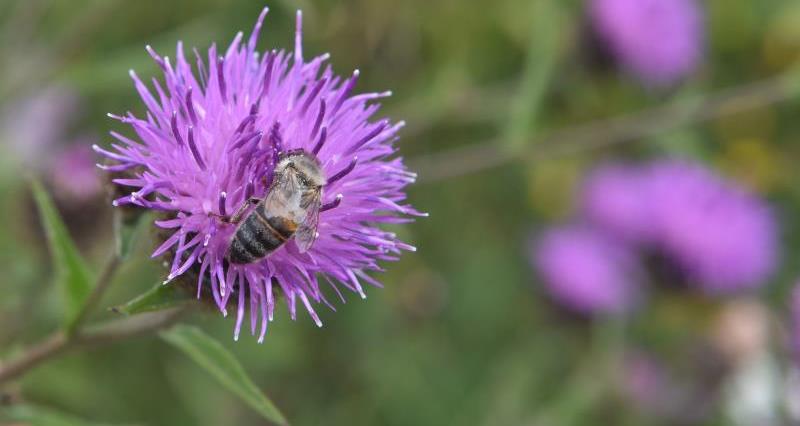Farmers attending two recent Campaign for the Farmed Environment events heard from experts that supporting pollinators and crop pest predators can help improve crop yields, delivering a win-win for farming and wildlife.
At the Hertfordshire event, Professor Richard Pywell (Centre for Ecology and Hydrology) spoke; while Dr Jonathan Storkey (Rothamsted Research) presented in Gloucestershire.
The invited experts shared their findings from a six-year, large-scale study on a commercial arable farm with field beans, oilseed rape and wheat. Improved pollination combined with natural pest control led to increased crop yields, especially in field beans which saw a 35% increase. With improved yields overall, farm output was largely unaffected by taking 3% to 8% of land at field edges out of production to create habitats for beneficials. This will encourage farmers looking to increase crop yields while minimising their environmental impact.
Hertfordshire host farmer Robert Law said: “It’s all about having the right habitat, in the right quantity, in the right place. You don’t need a lot to make a difference.”
CFE supports Bees’ Needs Week (17-23 July) which raises awareness of the ways everyone can help pollinators and celebrates successful pollinator projects across the country. Some 1,500 species of insects pollinate UK crops, contributing an estimated £600m to the nation’s economy.
CFE Project Officer Anna Cuckow said: “Many farmers are taking steps to provide food and a home for pollinators. Since 2014, over 1,750 farmers have benefitted from the practical guidance offered by CFE co-ordinators at more than 90 farm walks. In addition, as a result of two discounted seed mixes from Kings and Syngenta, 1,500ha of flowers providing pollen and nectar have been sown, enhancing the biodiversity of over 50,000ha of farmland. Sowing mixes on the least productive, awkward field corners which occur on nearly every farm helps both bees and farm productivity.”
Ways to help pollinators include looking after existing flower-rich areas, pollen and nectar mixes or grass leys with legumes and wildflowers, cutting hedges once every three years to allow flowering and planting hedge gaps with flowering native shrubs. Tussocky grass and grass buffers also provide essential overwintering habitats for some bee species. These are measures every farmer can adopt voluntarily, outside or alongside a stewardship agreement, while farming productively.
:: Information about the ASSIST Project can be found at www.ceh.ac.uk/our-science/projects/ASSIST
About the CFE
The Campaign for the Farmed Environment encourages voluntary management that will benefit the environment, whilst ensuring efficient and profitable food production. The CFE also showcases the work that farmers and land managers do to encourage wildlife, protect soil and water resources and support farmland birds.
CFE is a partnership, supported by many organisations committed to both agriculture and the environment (AHDB, AIC, AICC, BASIS, British Grassland Association, Bumblebee Conservation Trust, CAAV, CLA, DEFRA, Environment Agency, The FWAG Association, GWCT, LEAF, Hedgelink, Natural England, NFU, the Rivers Trusts/CaBA, RSPB, TFA, The Wildlife Trusts and Water UK).
CFE collaborates with other voluntary industry-led initiatives (Greenhouse Gas Action Plan, Tried & Tested and The Voluntary Initiative) to demonstrate how the industry collectively takes responsibility for achieving environmental benefit alongside profitable farming.

